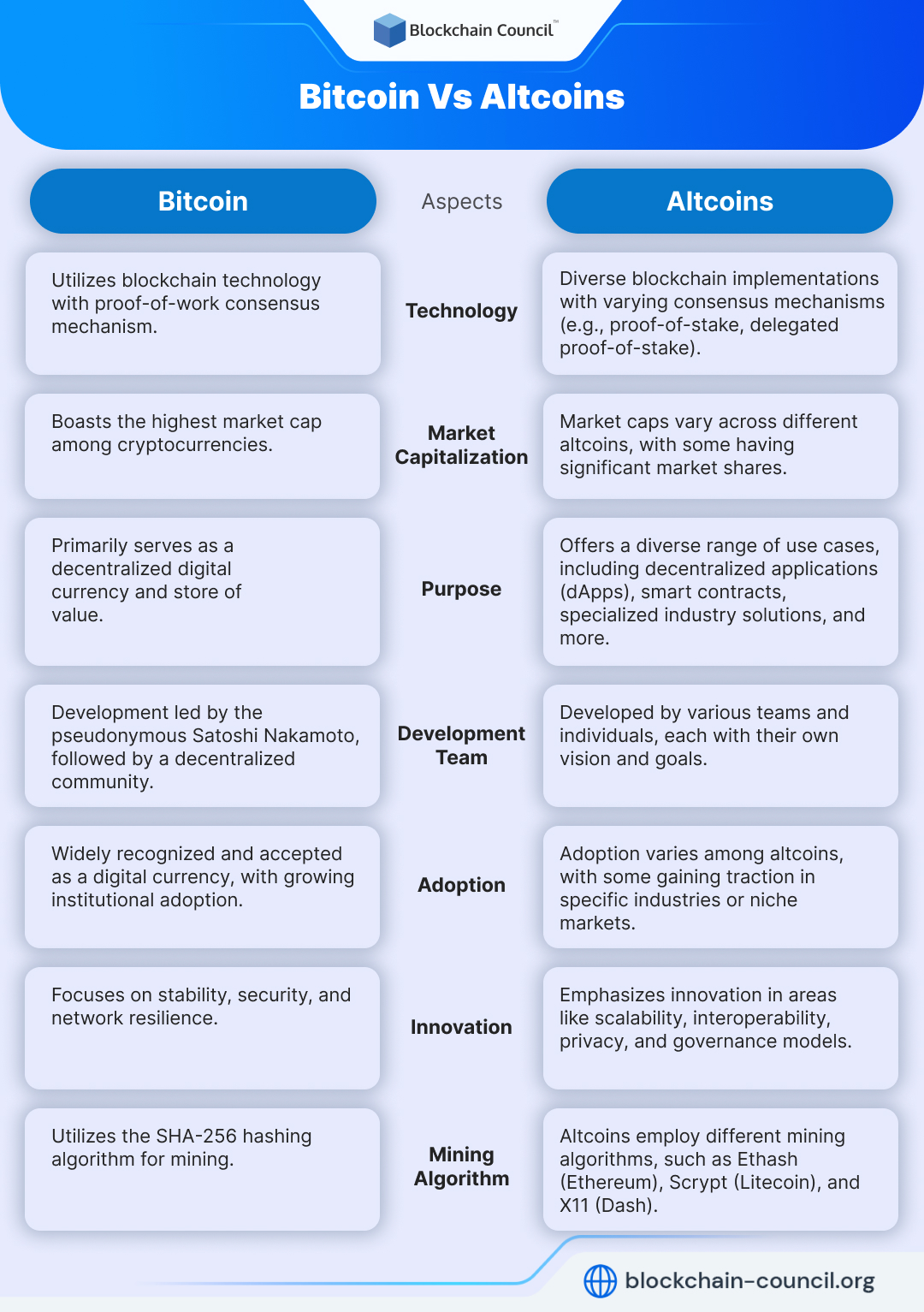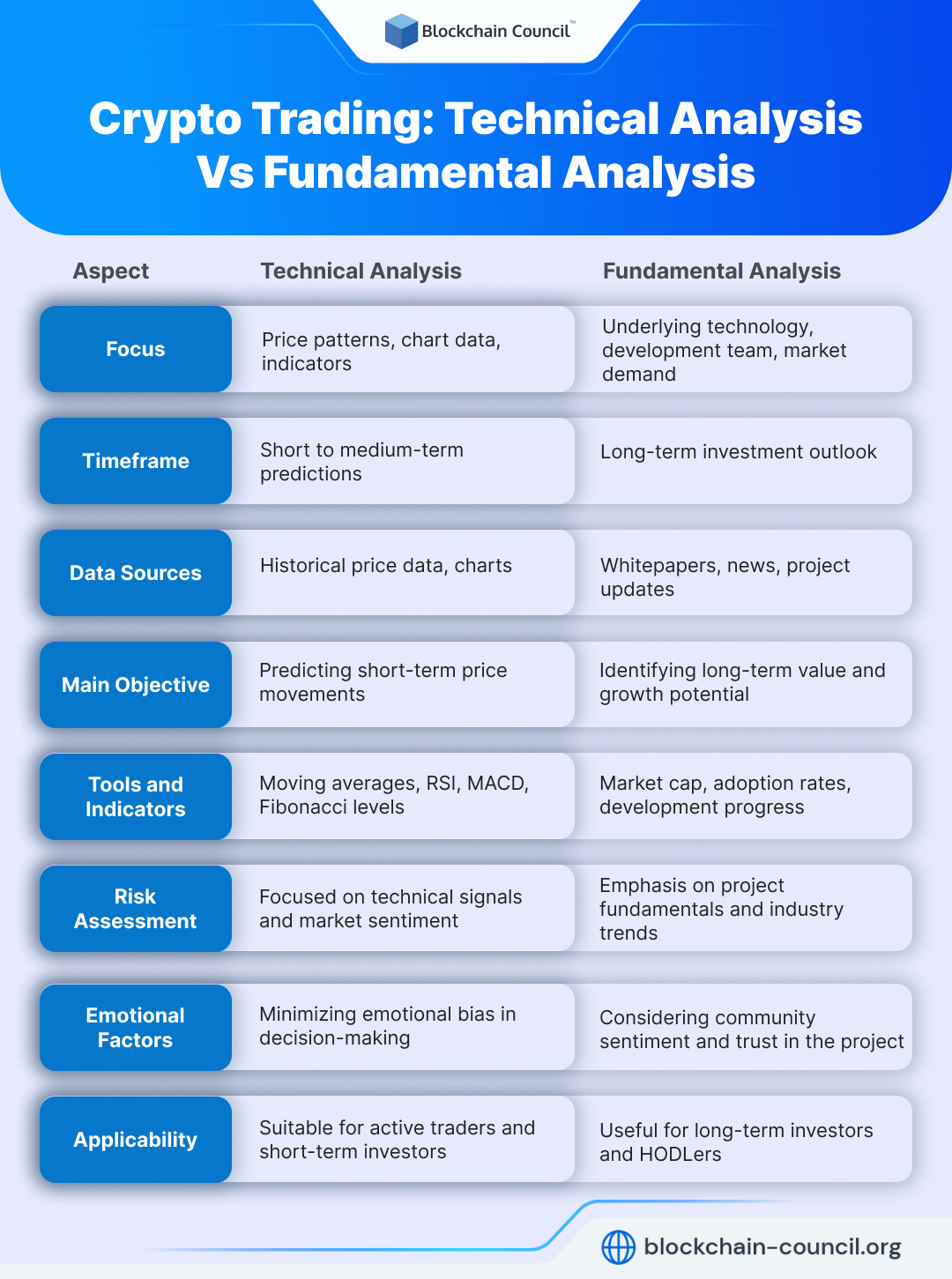
- Blockchain Council
- June 19, 2024
Welcome to The Ultimate Cryptocurrency Guide, your comprehensive resource to navigate the dynamic world of digital currencies. Picture a world where money transcends borders, is immune to censorship, and operates independently of centralized control. This is the power of cryptocurrencies.
In this article, we’ll delve into the fascinating world of cryptocurrencies, uncovering the technical aspects and providing in-depth analysis to help you understand the underlying principles. Our goal is not only to educate but also to assist you in outranking your competitors by crafting a content-rich piece that captivates readers and addresses their questions effectively. So, let’s dive in and explore the key aspects of this digital revolution.
Definition of Cryptocurrency
Cryptocurrency, a digital form of currency, has become a captivating and transformative force in the world of finance. It is a decentralized and encrypted medium of exchange that relies on cryptography for secure transactions and control of additional unit creation. Unlike traditional currencies issued by central banks, cryptocurrencies operate independently of any government or financial institution.
Cryptocurrencies, such as Bitcoin, Ethereum, and Litecoin, are built on cutting-edge Blockchain technology. This distributed ledger system ensures transparency, immutability, and security for every transaction. Each cryptocurrency functions as a unique digital asset with its own set of features, use cases, and underlying principles.
Brief History of Cryptocurrency
To grasp the significance of cryptocurrencies, it’s essential to understand their intriguing origins. The concept of digital currency emerged in the 1980s, but it wasn’t until the launch of Bitcoin in 2009 that the world witnessed the birth of a truly decentralized and peer-to-peer electronic cash system.
Satoshi Nakamoto, the anonymous creator of Bitcoin, released the whitepaper titled “Bitcoin: A Peer-to-Peer Electronic Cash System.” This milestone publication outlined the principles and mechanics of this revolutionary cryptocurrency. Bitcoin’s underlying technology, Blockchain, allows for trustless and verifiable transactions without the need for intermediaries.
Since Bitcoin’s inception, the cryptocurrency landscape has expanded exponentially. Numerous altcoins (alternative cryptocurrencies) have emerged, each offering unique features and applications. Ethereum, for instance, introduced smart contracts, enabling the creation of decentralized applications (dApps) and fueling the rise of decentralized finance (DeFi).
Key milestones in the history of cryptocurrencies
Certified Three.Js Developer™
7 Hours | Self-Paced
Join Now
Importance and Benefits of Cryptocurrency
Cryptocurrencies hold immense importance and offer a wide array of benefits, revolutionizing various aspects of our lives. Let’s delve into some key advantages:
- Decentralization and Empowerment: Cryptocurrencies eliminate the need for intermediaries, allowing individuals to have direct control over their finances. This decentralized nature empowers users, providing financial freedom and autonomy.
- Security and Privacy: Cryptocurrencies employ robust cryptographic techniques to ensure secure transactions. Blockchain technology provides an immutable record of all transactions, making it highly resistant to fraud and tampering. Additionally, cryptocurrencies can offer varying levels of privacy, giving users control over their personal information.
- Global Accessibility: Cryptocurrencies transcend borders, enabling seamless cross-border transactions without the need for traditional banking systems. This accessibility is particularly beneficial for the unbanked and underbanked populations, providing them with financial inclusion and opportunities for economic growth.
- Innovation and Disruption: The advent of cryptocurrencies has spurred unprecedented innovation and disruption across multiple industries. From decentralized finance and non-fungible tokens (NFTs) to supply chain management and voting systems, cryptocurrencies have opened new avenues for technological advancements.
- Investment Opportunities: Cryptocurrencies have emerged as a promising investment asset class. Their potential for high returns, diversification benefits, and the ability to invest with small amounts have attracted investors worldwide. However, it’s crucial to approach cryptocurrency investments with caution and conduct thorough research.
Types of Cryptocurrencies Bitcoin and Its Impact
Bitcoin, the pioneering cryptocurrency introduced by the enigmatic Satoshi Nakamoto, has left an indelible mark on the financial landscape. With its decentralized nature and secure Blockchain technology, Bitcoin offers an alternative to traditional monetary systems. Its impact is multifaceted, transcending borders and reshaping various industries. Let’s dive deeper into some of the key aspects of Bitcoin:
- Store of Value and Digital Gold: Bitcoin has emerged as a digital store of value, often referred to as “digital gold.” With a finite supply capped at 21 million coins, Bitcoin’s scarcity is one of its defining attributes. Its decentralized nature and resistance to inflation have positioned it as a hedge against traditional fiat currencies and a safe haven asset during economic uncertainties.
- Peer-to-Peer Electronic Cash: Beyond its store of value proposition, Bitcoin aims to revolutionize traditional payment systems. It enables fast and secure peer-to-peer transactions across the globe without the need for intermediaries such as banks. The Blockchain technology that underpins Bitcoin ensures transparency, immutability, and tamper-resistant transactions.
- Impact on Financial Inclusion: Bitcoin has the potential to address financial exclusion by providing access to banking services for the unbanked population. With a smartphone and an internet connection, individuals can participate in the global economy, transfer funds, and preserve their wealth, regardless of their geographical location or socio-economic status.
Alternative Cryptocurrencies (Altcoins)
While Bitcoin takes the spotlight, a vast array of alternative cryptocurrencies, known as altcoins, have emerged. These digital assets offer unique features, innovative technologies, and investment opportunities. Let’s explore some notable altcoins:
- Ethereum: Ethereum stands out as a Blockchain platform that goes beyond mere digital currency. It enables the creation of decentralized applications (dApps) and smart contracts, empowering developers to build a wide range of applications on its Blockchain. Ethereum’s native cryptocurrency, Ether (ETH), serves as a fuel for transactions within the network.
- Ripple: Ripple aims to transform the traditional cross-border payment systems by facilitating faster, more efficient, and cost-effective transactions. Its native cryptocurrency, XRP, acts as a bridge currency, facilitating the transfer of value between different fiat currencies. Ripple’s focus on partnerships with financial institutions has garnered significant attention.
- Litecoin: Introduced as the “silver to Bitcoin’s gold,” Litecoin shares many similarities with its predecessor but offers faster block generation times and a different hashing algorithm. Its ability to handle transactions more swiftly makes it suitable for day-to-day digital payments.
- Cardano: Cardano, a Blockchain platform founded on scientific research and peer-reviewed academic papers, aims to provide a secure and sustainable platform for the development of decentralized applications and smart contracts. Its native cryptocurrency, ADA, is used for transactions within the Cardano ecosystem.
Bitcoin Vs Altcoins
Blockchain Technology
Blockchain is a decentralized and distributed ledger that revolutionizes trust in digital transactions. It operates as a chain of blocks, each containing a set of transactions. What sets Blockchain apart is its immutability and transparency. Through cryptographic algorithms and consensus mechanisms, Blockchain ensures that once a transaction is recorded, it cannot be altered or tampered with. This transparency fosters trust among participants, removing the need for intermediaries and enabling peer-to-peer interactions.
How Blockchain Works
To comprehend the inner workings of Blockchain, we must grasp its key components and processes. At its core, Blockchain relies on cryptography, consensus algorithms, and distributed networks. Transactions are bundled into blocks, and each block contains a unique cryptographic hash, linking it to the previous block. This chaining mechanism ensures the integrity of the entire Blockchain.
Consensus algorithms play a pivotal role in Blockchain’s operation. Proof-of-Work (PoW) and Proof-of-Stake (PoS) are prominent consensus mechanisms. PoW involves miners competing to solve complex mathematical puzzles, validating and adding blocks to the chain. PoS, on the other hand, selects validators based on the number of tokens they hold. These mechanisms ensure security, prevent double-spending, and maintain the decentralized nature of Blockchain networks.
Applications of Blockchain – Real Life Case Studies
Cryptocurrencies
Cryptocurrencies emerged as the pioneering application of Blockchain technology. Bitcoin, the first decentralized digital currency, introduced the world to a secure, borderless, and permissionless financial system. Ethereum expanded the possibilities by introducing a programmable Blockchain, enabling the creation of decentralized applications and smart contracts.
Supply Chain Management
One of the significant applications of Blockchain technology lies in revolutionizing supply chain management. By utilizing Blockchain, the movement of goods and products throughout the supply chain can be tracked with enhanced efficiency and transparency. This implementation ensures the authenticity of products, improves traceability, and mitigates the risk of fraud. For instance, Walmart has harnessed Blockchain to monitor the journey of its produce from farm to store, resulting in reduced food waste and improved food safety.
Financial Services
The financial sector has also embraced Blockchain technology to facilitate secure and efficient financial transactions. From payments and loans to investments, Blockchain offers reduced costs, enhanced security, and increased transparency. Notably, banks are leveraging Blockchain to develop innovative payment solutions like instant and cross-border payments. Such advancements streamline financial processes and empower individuals with greater control over their financial transactions.
Healthcare
Blockchain technology has found its way into the healthcare industry, offering transformative benefits. By utilizing Blockchain to store and share medical data, patient care, research, and drug discovery are greatly improved. IBM, in collaboration with Pfizer, is actively working on a Blockchain-based platform to facilitate the secure sharing of clinical trial data. This application ensures data integrity, privacy, and seamless collaboration among healthcare stakeholders.
Real Estate
Blockchain’s potential extends to the real estate sector, where it can revolutionize property ownership records. By employing Blockchain, the tracking of property ownership becomes more transparent and secure, significantly reducing the risks of fraud. Companies like Propy have adopted Blockchain to streamline real estate transactions, making the process more efficient and trustworthy.
Intellectual Property
The protection of intellectual property, including copyrights and patents, is a critical concern in today’s digital world. Blockchain technology offers a robust solution by providing a decentralized and immutable ledger. By utilizing Blockchain, ownership records of intellectual property can be securely stored and tracked, significantly reducing counterfeiting and piracy. Notably, Everledger has successfully implemented Blockchain to track the ownership and provenance of diamonds, ensuring transparency and authenticity.
Other
Provenance: In the luxury goods industry, Provenance utilizes Blockchain to track the history and authenticity of products such as wine and watches. By leveraging Blockchain’s transparency and immutability, Provenance tackles counterfeiting and ensures that customers can trust the origin and quality of the goods they purchase.
TradeLens: TradeLens, a joint venture between IBM and Maersk, harnesses Blockchain to track the movement of containers worldwide. This application enhances efficiency and transparency in the shipping industry, reducing delays and providing stakeholders with real-time insights into the status of shipments.
We.Trade: We.Trade is a Blockchain-based platform that facilitates trade finance transactions. By leveraging Blockchain’s trust and transparency, We.Trade reduces costs and risks for businesses involved in international trade, streamlining financial processes and improving cross-border transactions.
Types of Cryptocurrency Wallets
Hardware Wallets
When it comes to maximum security, hardware wallets reign supreme. These physical devices, resembling USB flash drives, provide an offline storage solution for your cryptocurrencies. By keeping your private keys offline, away from potential online threats, hardware wallets offer unparalleled protection against hacking attempts.
Software Wallets
Software wallets, also known as desktop wallets, are applications that you install on your computer or mobile device. They provide a convenient way to access and manage your cryptocurrencies. Software wallets can be further categorized into hot wallets and cold wallets:
a) Hot Wallets: These wallets are connected to the internet, making them easily accessible for transactions. They are ideal for frequent trading and everyday usage but may be more susceptible to online attacks.
b) Cold Wallets: Cold wallets, on the other hand, operate offline, providing an added layer of security. By storing your private keys offline, cold wallets offer better protection against potential cyber threats. They are often used for long-term storage of cryptocurrencies.
Paper Wallets
While digital storage has become the norm, paper wallets offer a unique offline approach. A paper wallet is a physical printout containing your public and private keys. By generating and printing the wallet offline, you minimize the risk of online attacks. However, it’s important to store paper wallets securely, as they can be vulnerable to physical damage or loss.
Security Measures for Wallets
Protecting your cryptocurrency holdings requires implementing robust security measures. Here are some essential steps to keep your wallets secure:
- Strong Passwords: Create complex and unique passwords for your wallets. Avoid using easily guessable information and consider using a reputable password manager to store them securely.
- Two-Factor Authentication (2FA): Enable 2FA whenever possible to add an extra layer of security. By requiring an additional verification step, such as a unique code generated by an authenticator app, you significantly reduce the risk of unauthorized access.
- Wallet Backup: Regularly backup your wallet’s data and store it securely in multiple locations. This ensures that even if your device is lost or damaged, you can restore your wallet and access your funds.
- Firmware/Software Updates: Stay vigilant and keep your wallet’s firmware or software up to date. Developers frequently release updates to address security vulnerabilities, and by staying current, you benefit from the latest security enhancements.
- Offline Storage: Consider utilizing offline storage options such as hardware wallets or paper wallets for long-term holdings. By keeping your private keys offline, you minimize the risk of online attacks targeting your funds.
- Beware of Phishing Attempts: Exercise caution when interacting with cryptocurrency-related websites or links. Beware of phishing attempts that aim to steal your sensitive information. Always double-check URLs, verify the authenticity of websites, and never share your private keys or seed phrases with anyone.
Investing in Cryptocurrencies
Factors to Consider Before Investing
1. Risk Assessment
Investing in cryptocurrencies, like any investment, comes with its own set of risks. Understanding and evaluating these risks is crucial before diving into the world of digital currencies. Here are some aspects to consider:
- Cryptocurrency Volatility: Cryptocurrencies are known for their price volatility, which can result in significant fluctuations in value. Assess your risk tolerance and consider the potential impact on your investment portfolio.
- Market Manipulation: Cryptocurrency markets can be susceptible to manipulation due to their decentralized nature and lower liquidity compared to traditional financial markets. Stay informed about market trends, analyze trading volumes, and be cautious of suspicious activities.
- Security Risks: The security of your digital assets is paramount. Familiarize yourself with best practices for securing your cryptocurrencies, such as using secure wallets and employing two-factor authentication.
2. Market Analysis
Thorough market analysis is essential for making informed investment decisions. Consider the following aspects when evaluating the cryptocurrency market:
Project Evaluation: Examine the underlying technology, the project’s goals, the team behind it, and the level of community engagement. Assess the potential for adoption, scalability, and long-term viability.
- Market Capitalization: Market capitalization indicates the size and value of a cryptocurrency. Analyze market capitalization in relation to other cryptocurrencies to gain insights into relative market positions and potential growth opportunities.
- Trading Volume and Liquidity: Higher trading volumes and liquidity enable easier buying and selling of cryptocurrencies. Consider the liquidity of the cryptocurrency you intend to invest in, as it impacts your ability to execute trades and manage risk effectively.
- Market Trends and News: Stay up-to-date with the latest market trends, news, and regulatory developments. Monitor reputable cryptocurrency news sources, social media channels, and industry events to stay ahead of the curve.
3. Regulatory Considerations
The regulatory landscape surrounding cryptocurrencies varies across countries and continues to evolve. Be aware of the regulatory environment in your jurisdiction, as it can impact the legality, taxation, and overall stability of cryptocurrency investments. Here are a few key points to consider:
- Legal Status: Understand the legal status of cryptocurrencies in your country. Some governments have embraced cryptocurrencies, while others have imposed restrictions or bans. Stay informed about any regulatory changes that may affect your investments
- Taxation: Cryptocurrency taxation policies differ across jurisdictions. Familiarize yourself with the tax obligations related to cryptocurrency investments, such as capital gains taxes, and ensure compliance with the applicable laws.
- Investor Protection: Research the regulatory frameworks and investor protection measures in place to safeguard your interests. Look for reputable cryptocurrency exchanges and platforms that adhere to industry standards and prioritize security.
Steps to Get Started with Cryptocurrency Investments
Step 1: Setting Up a Digital Wallet
Before you start investing in cryptocurrencies, it’s crucial to set up a secure digital wallet to store your digital assets. A digital wallet acts as your personal bank account in the crypto realm, providing a safe space to store, send, and receive cryptocurrencies. There are various types of wallets available, including hardware wallets, software wallets, and online wallets. Research and choose a wallet that aligns with your security preferences and convenience.
Step 2: Choosing a Cryptocurrency Exchange
Once you have a digital wallet, the next step is to select a reliable cryptocurrency exchange. Exchanges serve as marketplaces where you can buy, sell, and trade cryptocurrencies. When choosing an exchange, consider factors such as security measures, user interface, available cryptocurrencies, liquidity, and fees. Some popular exchanges include Coinbase, Binance, and Kraken. Conduct thorough research and opt for an exchange that best suits your needs.
Step 3: Creating an Investment Strategy
Investing in cryptocurrencies requires a well-thought-out strategy to maximize your chances of success. Here are key considerations when crafting your investment strategy:
- Research and Education: Stay informed about the latest trends, news, and developments in the cryptocurrency market. Understand the underlying technology, market dynamics, and potential risks involved.
- Risk Assessment: Assess your risk tolerance and establish clear investment goals. Cryptocurrencies can be highly volatile, so it’s important to determine the level of risk you’re comfortable with.
- Portfolio Allocation: Diversification is a fundamental principle in investment. Allocate your investments across different cryptocurrencies to mitigate risk. Consider the market capitalization, technological innovation, and long-term potential of each cryptocurrency.
- Dollar-Cost Averaging (DCA): DCA involves investing a fixed amount at regular intervals, regardless of the cryptocurrency’s price. This strategy helps smooth out market volatility and reduces the risk of making poor investment decisions based on short-term fluctuations.
- Fundamental and Technical Analysis: Combine fundamental analysis (evaluating the project’s team, partnerships, and real-world applications) with technical analysis (analyzing price charts and patterns) to make well-informed investment decisions.
Step 4: Diversification Techniques
Diversification is crucial in managing risk and optimizing your cryptocurrency investment portfolio. Consider the following diversification techniques:
- Cryptocurrency Categories: Allocate investments across different cryptocurrency categories, such as established cryptocurrencies (Bitcoin, Ethereum), platform tokens (NEO, EOS), privacy coins (Monero, Zcash), and decentralized finance (DeFi) tokens.
- Market Cap Distribution: Diversify your holdings across cryptocurrencies with different market capitalizations. While larger market cap cryptocurrencies may provide stability, smaller market cap coins offer greater growth potential.
- Geographical Distribution: Consider diversifying your cryptocurrency holdings across different geographical regions. Cryptocurrency adoption and regulations vary across countries, offering unique investment opportunities.
- Long-Term vs. Short-Term Investments: Balance your portfolio with a mix of long-term investments in established cryptocurrencies and potentially higher-yield short-term investments in emerging projects.
Cryptocurrency Trading
Basics of Cryptocurrency Trading
Cryptocurrency trading is the process of buying, selling, and exchanging digital assets using various online platforms known as cryptocurrency exchanges. These exchanges enable individuals to trade a wide range of cryptocurrencies, including Bitcoin, Ethereum, Ripple, and many others.
Understanding Market Orders
When you enter the cryptocurrency market, you’ll encounter different types of trading orders. The first one to grasp is the market order. A market order is a straightforward instruction to buy or sell a cryptocurrency at the best available price in the market. It guarantees swift execution of your trade, ensuring you don’t miss out on favorable opportunities. Market orders are particularly useful when you aim to enter or exit a position promptly.
Types of Trading Orders
Apart from market orders, there are several other types of trading orders that offer varying degrees of control and flexibility:
- Limit Orders: A limit order allows you to set specific price parameters for buying or selling a cryptocurrency. By determining the maximum price you’re willing to pay or the minimum price you seek to receive, you gain more control over your trading decisions. Limit orders are effective for traders who prefer a strategic approach and are willing to wait for the market to reach their desired price levels.
- Stop Orders: Stop orders are designed to mitigate potential losses or secure profits. There are two main types of stop orders: stop-loss orders and take-profit orders. A stop-loss order automatically sells your cryptocurrency if its price reaches a predetermined level, limiting your losses. Conversely, a take-profit order allows you to lock in profits by selling your cryptocurrency once it reaches a specific target price.
- Trailing Stop Orders: Trailing stop orders offer a dynamic approach to managing your trades. This order type allows you to set a trailing percentage or a fixed value, which trails the cryptocurrency’s price as it moves in your favor. If the price reverses by the set percentage or value, the order is triggered, helping you secure profits while allowing potential gains to accumulate.
Technical Analysis vs. Fundamental Analysis
Popular Cryptocurrency Trading Strategies
Cryptocurrency trading is a dynamic endeavor that involves buying, selling, and exchanging digital assets on various platforms. To maximize your trading success, it’s essential to employ well-defined strategies that align with your goals and risk tolerance. Let’s explore some popular cryptocurrency trading strategies:
Day Trading
Day trading is a strategy where traders aim to profit from intraday price movements. Day traders open and close positions within the same trading day, avoiding overnight exposure to market risks. This strategy requires active monitoring of price charts, volume, and market news to identify short-term trading opportunities. Day traders often leverage technical analysis, chart patterns, and indicators to make quick trading decisions.
Trend Trading
Trend trading is a strategy based on identifying and riding the momentum of price trends. Traders utilizing this approach aim to capture profits by entering positions when a cryptocurrency’s price is trending upwards or downwards. Technical indicators such as moving averages and trend lines are commonly employed to identify potential entry and exit points. By following the trend, traders can capitalize on price movements and minimize the impact of short-term fluctuations.
Breakout Trading
Breakout trading focuses on identifying key price levels where a cryptocurrency’s value breaks through established support or resistance levels. Traders employing this strategy aim to take advantage of significant price movements that often occur after a breakout. By carefully monitoring chart patterns, volume, and volatility, breakout traders can position themselves to benefit from sudden price surges or downturns.
Swing Trading
Swing trading involves capitalizing on short-to-medium-term price fluctuations within an established trading range. Traders utilizing this strategy aim to capture profits by entering and exiting positions during price swings. Technical analysis tools, such as oscillators and candlestick patterns, can help identify potential entry and exit points. Swing trading requires patience and a keen eye for market trends, as traders seek to profit from both upward and downward price movements.
Scalping
Scalping is a high-frequency trading strategy that aims to profit from small, rapid price movements. Traders employing this approach enter and exit positions swiftly, often within minutes or seconds, leveraging tight spreads and quick market fluctuations. This strategy requires precision timing, advanced technical analysis, and a deep understanding of market liquidity. Scalpers often target highly liquid cryptocurrencies with low trading fees to optimize their trading opportunities.
Hodling (Long-Term Holding)
Hodling, derived from a misspelling of “holding,” refers to the strategy of buying and holding cryptocurrencies for the long term, irrespective of short-term market fluctuations. This approach is often adopted by investors who believe in the long-term potential of specific cryptocurrencies. Hodlers rely on fundamental analysis, industry trends, and technological advancements to make informed investment decisions. By staying invested over extended periods, hodlers aim to maximize potential returns as the cryptocurrency ecosystem matures.
Risk Management in Cryptocurrency Trading
Setting Stop-Loss Orders
When it comes to cryptocurrency trading, setting stop-loss orders is a vital risk management tool. A stop-loss order is a predetermined trigger that automatically executes a sell order when a specified price level is reached. By utilizing stop-loss orders, you establish a safety net that limits potential losses during market downturns. It’s important to set stop-loss levels based on careful analysis and your risk tolerance, ensuring they strike a balance between protection and avoiding premature exits. This technique empowers you to stay in control even when the markets are volatile, safeguarding your capital and emotional well-being.
Example: Imagine you’ve purchased Bitcoin at $50,000 per coin, expecting its value to rise. However, the market sentiment shifts, and the price starts to decline. By setting a stop-loss order at $48,000, you instruct the exchange to automatically sell your Bitcoin if the price reaches that level.
Managing Position Sizes
Properly managing position sizes is another critical aspect of risk management in cryptocurrency trading. Position size refers to the amount of capital allocated to a specific trade. By determining an appropriate position size, you control the level of risk exposure and protect yourself from substantial losses. As a general rule, it’s advisable to limit your position size to a small percentage of your overall trading capital. This approach helps diversify your portfolio, mitigates potential losses, and allows for greater flexibility in adapting to market fluctuations. Remember, prudent risk management is the foundation of long-term success in the crypto market.
Example: Suppose you have a trading capital of $10,000, and you want to invest in Ethereum. Applying prudent risk management, you decide to allocate only 5% of your capital to a single trade, which amounts to $500.
Identifying and Avoiding Scams
The world of cryptocurrency is not immune to scams and fraudulent schemes. Protecting yourself from such threats is crucial for preserving your investments and maintaining a secure trading environment. One effective strategy is to thoroughly research and verify the legitimacy of any project, exchange, or investment opportunity before committing your funds. Look for transparency, regulatory compliance, and reputable team members within the project. Additionally, staying informed about common scam tactics, such as phishing attempts and Ponzi schemes, enables you to spot warning signs and avoid falling victim to fraudulent activities. Vigilance and skepticism are your allies in the quest for a scam-free trading experience.
Example: Let’s say you come across a new cryptocurrency project that promises extraordinary returns with minimal risk. Before investing, you conduct thorough research and discover that the project lacks transparency, has no clear roadmap, and the team behind it has no credible background. These are red flags indicating a potential scam.
Cryptocurrency Mining
Introduction to Cryptocurrency Mining
Cryptocurrency mining has emerged as a fascinating and integral part of the digital currency ecosystem. It involves the process of validating and verifying transactions on a Blockchain network while also minting new coins. Unlike traditional banking systems where central authorities oversee transactions, cryptocurrency mining employs decentralized networks that rely on miners to maintain the integrity and security of the system.
At its core, cryptocurrency mining serves two crucial functions: transaction validation and coin issuance. Miners use powerful computers to solve complex mathematical problems that validate transactions. Once a miner successfully solves the problem, the verified transactions are added to the Blockchain, ensuring their immutability and security
Types of Cryptocurrency Mining
There are several types of cryptocurrency mining, each with its own advantages and disadvantages. The most common types of mining are:
- CPU mining: This is the oldest and most basic type of mining. It uses the central processing unit (CPU) of a computer to solve mathematical problems and earn cryptocurrency rewards. CPU mining is not very efficient, but it is a good option for those who want to mine cryptocurrency with a low-cost setup.
- GPU mining: This type of mining uses graphics processing units (GPUs) to solve mathematical problems. GPUs are much more powerful than CPUs, so they can mine cryptocurrency much faster. GPU mining is more efficient than CPU mining, but it also requires a more powerful and expensive setup.
- ASIC mining: ASIC stands for application-specific integrated circuit. ASIC miners are specialized devices that are designed specifically for mining cryptocurrency. ASIC miners are the most efficient type of mining, but they are also the most expensive.
- FGPA mining: FPGA stands for field-programmable gate array. FPGA miners are similar to ASIC miners, but they are more flexible and can be programmed to mine different cryptocurrencies. FPGA mining is a good option for those who want to mine a variety of cryptocurrencies.
- Cloud mining: Cloud mining is a way to mine cryptocurrency without having to purchase any hardware. Cloud mining companies rent out their mining power to users, who can then earn cryptocurrency rewards. Cloud mining is a more affordable option than buying your own mining hardware, but it is also less profitable.
The best type of mining for you will depend on your budget, your goals, and your technical expertise. If you are just starting out, CPU mining is a good option. If you are more serious about mining, you may want to consider GPU mining or ASIC mining. If you do not want to purchase any hardware, cloud mining is an option.
Pros and Cons Of Popular Types of Crypto Mining
Types of Consensus Mechanisms
1. Proof of Work (PoW)
Proof of Work (PoW) represents the widely recognized consensus mechanism adopted by prominent cryptocurrencies like Bitcoin and various others. PoW mining entails a competition among miners to solve intricate mathematical puzzles, leveraging computational power. The miner who successfully solves the puzzle first gains the privilege of adding the next block of transactions to the Blockchain and receives newly minted coins as a reward.
PoW mining necessitates substantial computational resources, including high-performance hardware, and consumes a significant amount of energy. Nevertheless, it offers a robust and secure network, as altering past transactions would require an extraordinary amount of computational power.
2. Proof of Stake (PoS)
Proof of Stake (PoS) presents an alternative consensus mechanism that addresses the energy consumption concerns associated with PoW mining. In PoS, mining no longer hinges on computational power; instead, block validators are selected based on the number of coins they hold and “stake” within the network.
Within PoS mining, validators are chosen to create new blocks through a combination of random selection and the size of their stake. Validators are incentivized to maintain network security and integrity since they risk losing their staked coins in case of malicious behavior. This energy-efficient approach has gained popularity and is utilized by cryptocurrencies such as Cardano and Tezos.
3. Other Consensus Mechanisms
While PoW and PoS stand as prominent consensus mechanisms, the cryptocurrency realm witnesses ongoing exploration of innovative approaches to mining.
- Proof of Authority (PoA): PoA relies on a limited number of approved validators responsible for verifying transactions based on their authority or identity, rather than computational power or stake. This consensus mechanism is often employed in private or consortium Blockchains, facilitating faster transaction times and scalability.
- Delegated Proof of Stake (DPoS): DPoS introduces a voting system enabling token holders to elect a group of delegates responsible for validating transactions on their behalf. These elected delegates take turns producing blocks, enhancing transaction speed and scalability.
- Proof of Capacity (PoC): PoC mining capitalizes on available storage space on miners’ devices to solve cryptographic puzzles. This mechanism prioritizes energy efficiency by reducing reliance on computational power, making it suitable for eco-conscious cryptocurrencies.
- Proof of Activity (PoA): PoA represents a hybrid consensus mechanism combining elements of both PoW and PoS. In PoA, miners must solve mathematical problems to add new blocks to the Blockchain, while also being rewarded for staking their cryptocurrency. PoA offers greater energy efficiency compared to PoW, yet comes with a lower level of security.
Pros and Cons of Popular Consensus Mechanisms
Mining Hardware and Software
ASICs (Application-Specific Integrated Circuits)
In the realm of cryptocurrency mining, ASICs reign supreme. These specialized hardware devices are designed with a singular purpose: to maximize mining efficiency for specific cryptocurrencies. Unlike general-purpose CPUs or GPUs, ASICs are tailored to execute the complex algorithms that underpin the cryptographic puzzles miners solve.
By leveraging the power of ASICs, miners can achieve remarkable hash rates and significantly enhance their chances of earning rewards. Bitcoin, for example, utilizes ASICs to efficiently mine its Blockchain, as the complexity of its hashing algorithm requires immense computational power. When considering ASICs, it’s crucial to select models that align with your chosen cryptocurrency, ensuring optimal performance and return on investment.
Some of the most notable ASIC miners in the market include the Bitmain Antminer S19 Pro, the WhatsMiner M30S++, and the Canaan AvalonMiner 1246.
GPUs (Graphics Processing Units)
While ASICs dominate Bitcoin mining, GPUs have carved their niche in various alternative cryptocurrencies. Originally designed for rendering graphics in video games, GPUs possess remarkable parallel processing capabilities that can be harnessed for mining purposes. Their versatility and computational power make them an attractive choice for miners seeking flexibility across different cryptocurrencies.
GPU mining rigs comprise multiple graphics cards, working in unison to solve mining algorithms. Ethereum, among other cryptocurrencies, relies heavily on GPU mining. The decentralized nature of Ethereum’s network and its algorithm’s compatibility with GPU architecture provide an opportunity for individual miners to participate actively. Additionally, GPUs can be repurposed for other tasks, making them an adaptable asset within the mining ecosystem.
Popular GPU miners such as the Nvidia GeForce RTX 3080 Ti and the AMD Radeon RX 6900 XT provide ample processing power, enabling miners to venture into diverse cryptocurrencies with confidence.
Mining Software and Pools
Mining software acts as the bridge between your mining hardware and the cryptocurrency network you aim to mine. These programs enable miners to connect their devices to the Blockchain, facilitate communication with mining pools, and monitor the overall mining process. Choosing the right mining software is crucial for optimizing efficiency and maximizing mining rewards.
Mining pools, on the other hand, allow individual miners to collaborate and combine their computational power. By pooling resources, miners increase their chances of solving mining puzzles and earning rewards more consistently. Pools distribute rewards among participants based on their contributed hash power, fostering a more predictable income stream for miners.
Renowned mining software like CGMiner, Awesome Miner, and HiveOS offer robust features and user-friendly interfaces, empowering miners to optimize their operations effectively.
Mining Profitability and Considerations
Energy Consumption and Environmental Impact
Mining cryptocurrencies involves solving complex mathematical problems, which requires significant computational power and, consequently, energy consumption. This energy-intensive process has raised concerns about its environmental impact. It’s important to understand the following aspects:
a) Environmental Considerations: Cryptocurrency mining, especially using proof-of-work (PoW) consensus algorithms, consumes substantial amounts of electricity. This energy demand primarily comes from mining rigs, which are equipped with powerful hardware. However, the industry has been actively seeking ways to address these concerns, such as transitioning towards more energy-efficient consensus mechanisms like proof-of-stake (PoS).
b) Renewable Energy and Sustainable Mining: To mitigate the environmental impact, many mining operations are exploring the use of renewable energy sources, such as solar and wind power. Embracing sustainable practices can significantly reduce carbon footprints and make mining operations more eco-friendly.
Mining Difficulty and Rewards
Mining difficulty and the rewards associated with it play a crucial role in determining the profitability of cryptocurrency mining. Let’s delve into these two interconnected aspects:
a) Mining Difficulty: As more miners join the network, the mining difficulty increases. This adjustment ensures that new blocks are generated at a consistent rate. However, rising mining difficulty means miners require more computational power, which translates to higher electricity costs and hardware investments.
b) Mining Rewards: Miners are rewarded for successfully adding new blocks to the Blockchain. The two main types of rewards are block rewards and transaction fees. Block rewards are predetermined and reduced over time, while transaction fees vary based on network demand. Understanding the reward structure is essential for assessing mining profitability and evaluating potential returns on investment.
Cloud Mining and Mining Contracts
Cloud mining has emerged as an alternative to traditional mining setups. It involves renting mining hardware remotely and benefiting from shared resources. Here’s what you need to know:
a) Pros and Cons of Cloud Mining: Cloud mining offers several advantages, including lower upfront costs, no maintenance requirements, and the ability to mine multiple cryptocurrencies simultaneously. However, it also comes with certain drawbacks, such as limited control over mining operations, potential scams, and the reliance on the cloud mining service provider’s infrastructure.
b) Mining Contracts: When engaging in cloud mining, miners typically enter into mining contracts with service providers. These contracts specify the terms and conditions, including the mining duration, allocated hash rate, and expected returns. It’s crucial to thoroughly research and choose reputable cloud mining providers to minimize the risks associated with such arrangements.
Real life case studies and considerations
Case study: In 2017, the University of Cambridge estimated that Bitcoin mining consumed as much electricity as the entire country of Denmark, accounting for about 0.1% of global electricity consumption.
In 2022, Argo Blockchain, a UK-based crypto mining company, announced that it would be shutting down two of its mining facilities in Iceland. The company cited the high cost of electricity in Iceland as the reason for the decision.
Another 2022 study by the University of Cambridge estimated that the global electricity consumption of crypto mining had reached 204 terawatt-hours (TWh). This is equivalent to the annual electricity consumption of Argentina.
Considerations: Energy consumption is a significant concern in crypto mining due to its environmental impact. Miners compete to solve complex problems, requiring substantial energy. Choosing energy-efficient hardware, like ASIC miners, can help mitigate environmental concerns.
Case study: Bitcoin mining difficulty has been steadily increasing over time, leading to reduced mining rewards.
Considerations: Mining difficulty and rewards are crucial factors to assess mining profitability. High mining difficulty may render mining less profitable, while low rewards may not justify the investment of time and effort.
Case study: Cloud mining allows users to mine cryptocurrencies without purchasing hardware. However, caution is necessary when choosing cloud mining companies due to past cases of fraud.
Considerations: Cloud mining can be a viable option for those seeking to mine without investing in hardware. Researching and selecting reputable providers is crucial to avoid potential scams.
Case study: In 2014, a group of students in Iceland used old computers and cheap electricity to mine Bitcoin profitably for a few months. However, the increasing mining difficulty eventually rendered their operation unprofitable.
Considerations: This case study highlights the dynamic nature of mining profitability. Fluctuations in mining difficulty and rewards necessitate ongoing research to ensure profitability.
Case study: In 2017, Bitmain launched the Antminer S9, a powerful Bitcoin mining rig. While initially profitable, the increasing mining difficulty led to diminished rewards and reduced profitability for users of the Antminer S9.
Considerations: Hardware choice plays a significant role in mining profitability. Outdated or inefficient hardware may not yield substantial profits.
Case study: Mining facilities in China and Iceland have faced challenges. In 2019, the Chinese government cracked down on mining operations, causing shutdowns. In 2022, high electricity costs led UK-based Argo Blockchain to shut down facilities in Iceland. Similarly, Bitfarms sold off mining equipment to reduce operating costs.
Considerations: Regulatory changes and operational costs can impact mining profitability. Staying informed about geopolitical developments and optimizing expenses are essential.
Risks and Challenges in the Cryptocurrency Market
Volatility and Market Fluctuations
Cryptocurrency prices are notorious for their volatility and rapid fluctuations. Unlike traditional financial markets, digital currencies can experience substantial price swings within short periods. This unpredictability poses challenges for investors, making it difficult to accurately predict future prices and potentially resulting in significant losses.
For instance, let’s consider the case of Bitcoin. In 2022, its price plummeted in just a few weeks, catching many investors off guard. This sharp decline highlighted the inherent risks associated with investing in cryptocurrencies and emphasized the importance of a cautious approach.
To mitigate the effects of volatility, traders and investors employ various strategies such as technical analysis, fundamental research, and risk management techniques. By carefully monitoring market trends and making informed decisions, individuals can navigate the turbulent waters of cryptocurrency investing more effectively.
Scams and Ponzi Schemes
The cryptocurrency market has unfortunately attracted its fair share of scams and fraudulent schemes, particularly targeting those who are new to digital assets. These scams can result in substantial financial losses and erode the trust of potential investors.
One notorious example is the PlusToken scam, a Ponzi scheme that defrauded unsuspecting individuals of more than $3 billion. The perpetrators promised extravagant returns, luring in investors with false claims. However, the scheme operated on a fraudulent model, using funds from new investors to pay off the previous ones, ultimately leading to its collapse.
To protect themselves, individuals must exercise caution and stay vigilant. Conducting thorough research, verifying the legitimacy of investment opportunities, and seeking advice from trusted sources are essential practices for avoiding scams. Additionally, understanding the fundamental principles of Blockchain technology and recognizing warning signs can help investors identify potential fraudulent schemes.
Regulatory Uncertainty
The regulatory landscape surrounding cryptocurrencies is constantly evolving, creating uncertainty and challenges for investors. Governments and financial institutions worldwide are grappling with how to approach and regulate this emerging asset class, resulting in varied and often conflicting regulations.
An example of regulatory uncertainty can be seen in China’s decision to ban cryptocurrency trading and mining in 2021. This sudden move had a significant impact on Bitcoin’s price and highlighted the potential risks associated with investing in cryptocurrencies within jurisdictions where regulations are unclear or unfavorable.
As an investor, staying informed about the regulatory developments in your country or region is crucial. By understanding the legal framework and compliance requirements, you can make informed decisions while ensuring your investments align with applicable regulations.
Security and Privacy in Cryptocurrency
Importance of Security and Privacy
When it comes to cryptocurrencies, security and privacy are of paramount importance. Here’s why:
Protecting Your Assets: Cryptocurrencies provide financial sovereignty, allowing you to be in control of your funds without relying on intermediaries. However, this freedom comes with the responsibility of safeguarding your assets against potential threats, such as hacking, fraud, and theft. Implementing robust security measures ensures the protection of your hard-earned digital wealth.
Preserving Privacy: One of the founding principles of cryptocurrencies is preserving user privacy. By utilizing Blockchain technology, cryptocurrencies enable pseudonymous transactions. However, maintaining privacy in an increasingly connected world poses challenges. It is crucial to understand how to enhance your privacy and protect your personal information from prying eyes.
Best Practices for Securing Cryptocurrency
Now that we understand the significance of security and privacy in the realm of cryptocurrencies, let’s explore the best practices for safeguarding your digital assets.
Using Hardware Wallets: Hardware wallets offer an unparalleled level of security for your cryptocurrencies. These physical devices store your private keys offline, making it nearly impossible for hackers to gain unauthorized access. By keeping your private keys offline, hardware wallets mitigate the risks associated with online attacks and malware. They provide a secure environment for managing and signing transactions, giving you peace of mind.
Two-Factor Authentication (2FA): Implementing two-factor authentication adds an extra layer of security to your cryptocurrency accounts. By combining something you know (like a password) with something you have (such as a unique code from a mobile app), 2FA significantly reduces the risk of unauthorized access. It is essential to enable 2FA wherever possible, including cryptocurrency exchanges, wallets, and any other platforms associated with your digital assets.
Secure Password Management: Creating strong and unique passwords is crucial to protect your cryptocurrency accounts. Utilize password managers to generate and store complex passwords securely. Avoid reusing passwords across different platforms, as a single compromised account could lead to a cascade of security breaches. Regularly update your passwords and enable multi-factor authentication within your password manager for an added layer of protection.
Privacy Coins and Anonymity Features
Privacy coins represent a revolutionary class of cryptocurrencies designed to ensure the privacy and anonymity of their users. Employing innovative techniques such as ring signatures, stealth addresses, and coin mixing, privacy coins offer enhanced confidentiality compared to traditional cryptocurrencies. These digital currencies, such as Monero (XMR), Zcash (ZEC), and Dash (DASH), emphasize privacy-enhancing features by concealing transaction details, sender and recipient identities, and wallet balances.
- Ring Signatures: Ring signatures enable users to sign transactions without revealing their identities. By forming a group of public keys and utilizing one of those keys to sign the transaction, the actual key used remains concealed. This obfuscates the user’s identity, enhancing privacy and protecting against transaction tracing.
- Stealth Addresses: Stealth addresses empower users to receive payments without disclosing their identities. Each payment generates a unique address, ensuring that the sender is unaware of the recipient’s actual address. Consequently, the recipient remains anonymous, enhancing the overall privacy of transactions.
- Coin Mixing: Coin mixing services play a pivotal role in bolstering privacy by enabling users to mix their coins with those of other users. This process complicates the tracking of coin movements, making it challenging to associate specific transactions with individual users. By obscuring the transactional history, coin mixing services contribute significantly to enhancing privacy in cryptocurrency transactions.
- Using Coin Mixing Services: Several coin mixing services, such as Mixtum, Bitcoin Blender, and DarkWallet, provide users with the ability to enhance their privacy by mixing their coins with those of other users. This process makes tracking coin movements considerably more difficult and offers an added layer of protection for user privacy.
- Privacy Concerns and Regulatory Considerations: While privacy coins have garnered attention for their potential misuse in facilitating illicit activities, they also serve as vital tools for safeguarding individual privacy. As a result, regulators worldwide are grappling with the challenge of finding a balance between privacy preservation and preventing criminal activities such as money laundering and tax evasion. It is crucial for cryptocurrency users to stay informed about evolving regulations and adhere to applicable laws to ensure the secure and responsible utilization of privacy-focused features.
Additional Considerations
Privacy coins are not foolproof, and there are risks associated with tracking coin movements, even after mixing.
Responsible usage of privacy coins is paramount, as they can be exploited for illegal activities such as money laundering and tax evasion.
Privacy coins continue to undergo development, and addressing existing challenges is crucial for their widespread adoption and continued improvement.
Government Regulations and Legal Considerations
Current State of Cryptocurrency Regulations
The regulatory landscape for cryptocurrencies varies across countries, with some adopting aggressive approaches, while others take a more hands-off stance. Here’s an overview of contrasting regulatory approaches:
Aggressive Regulatory Approach: Several countries, including China, South Korea, and India, have implemented strict regulations on cryptocurrencies. China has banned cryptocurrency trading and mining, South Korea has imposed regulations on exchanges, and India has proposed regulations including a ban on anonymous transactions.
Hands-off Regulatory Approach: On the other hand, countries like the United States, Switzerland, and Malta have embraced a more lenient approach. While the United States has not yet implemented comprehensive regulations, there are existing regulations, such as anti-money laundering laws, that apply to cryptocurrencies. Switzerland and Malta have become hubs for cryptocurrency activities, fostering industry development through favorable regulatory environments.
The regulatory landscape for cryptocurrencies is expected to evolve further as governments grapple with the challenges and opportunities presented by this emerging technology.
Legal Challenges and Concerns
Cryptocurrencies have raised various legal challenges and concerns that need to be addressed. Some of the prominent issues include:
Money Laundering: Cryptocurrencies have been associated with instances of money laundering, raising concerns about their potential facilitation of illicit activities. Addressing the risk of money laundering is crucial for the legitimacy and wider acceptance of cryptocurrencies.
Tax Evasion: The decentralized nature of cryptocurrencies can create challenges in taxation enforcement, leading to concerns about potential tax evasion. Governments are actively exploring ways to ensure proper reporting and taxation of cryptocurrency transactions to preserve tax revenues.
Consumer Protection: The cryptocurrency market is not immune to fraudulent schemes and scams, making it essential to enhance consumer protection. Ensuring transparency, promoting responsible investment practices, and combating fraudulent activities are vital to safeguarding the interests of cryptocurrency investors.
Cybersecurity: Cryptocurrencies, being digital assets, are vulnerable to cyberattacks. The threat of hacking incidents poses significant risks, potentially resulting in the loss of cryptocurrencies and compromising user security. Robust cybersecurity measures and user education are critical for countering these challenges.
Taxation of Cryptocurrencies
Reporting Cryptocurrency Gains
When you sell your cryptocurrencies, it’s essential to be aware of potential capital gains taxes. The specific amount you owe will depend on the duration you held the cryptocurrency and your income tax bracket. To ensure compliance and accurately report your gains, consider the following steps:
Firstly, it is vital to maintain a record of your cryptocurrency transactions. This includes tracking the cost basis, as well as noting the date and price of each purchase and sale. By diligently documenting these details, you can confidently report your gains when tax season arrives.
To simplify the process, you can leverage the power of cryptocurrency tax calculators. These tools efficiently crunch the numbers and provide you with an accurate calculation of your capital gains. Whether you are a beginner or a seasoned professional, utilizing a cryptocurrency tax calculator saves time and minimizes the risk of errors.
Cryptocurrency Tax Tools and Services
Fortunately, an array of cryptocurrency tax tools and services exists to assist you in managing your tax obligations effectively. Let’s explore a few popular options:
CoinTracker: As a leading cryptocurrency tax calculator, CoinTracker offers a comprehensive solution for tracking your cryptocurrency transactions and calculating your capital gains taxes. With its user-friendly interface, CoinTracker simplifies the process for individuals at all levels of expertise.
CryptoTrader.Tax: Another notable cryptocurrency tax calculator is CryptoTrader.Tax. This tool provides seamless tracking of your cryptocurrency transactions and offers accurate calculations of your capital gains taxes. Whether you are a casual investor or a professional trader, CryptoTrader.Tax is designed to cater to your needs.
ZenLedger: For those seeking a more extensive service, ZenLedger serves as a cryptocurrency tax preparation platform. Beyond tracking transactions and calculating capital gains taxes, ZenLedger assists in filing your tax return, making the entire process streamlined and stress-free.
Remember, these examples merely scratch the surface of available cryptocurrency tax tools and services. It is essential to choose the option that aligns with your specific requirements and preferences.
Crypto taxations in different countries
Cryptocurrency and the Future of Finance
Decentralized Finance (DeFi)
Decentralized Finance, or DeFi for short, has emerged as a groundbreaking concept within the cryptocurrency space. It revolutionizes traditional financial systems by removing intermediaries and enabling peer-to-peer transactions through smart contracts on the Blockchain.
With DeFi, users have the opportunity to access a wide range of financial services, including lending, borrowing, decentralized exchanges, and more. It empowers individuals by granting them full control over their funds while providing transparency and security.
Innovative DeFi protocols like Compound, Aave, and Uniswap have gained significant traction, attracting both retail and institutional investors. These platforms offer high yields, liquidity mining, and governance mechanisms, creating a dynamic ecosystem that fosters innovation and experimentation.
However, it’s important to acknowledge that DeFi is still in its early stages and faces challenges such as scalability, user experience, and regulatory considerations. Nonetheless, its potential to reshape the financial landscape is undeniable, and we can expect further advancements in this space.
Examples
Aave: Aave is a decentralized lending protocol that allows users to lend and borrow cryptocurrencies without the need for a centralized intermediary.
Compound: Compound is another decentralized lending protocol that offers similar services to Aave.
Uniswap: Uniswap is a decentralized exchange that allows users to trade cryptocurrencies without the need for a centralized order book.
MakerDAO: MakerDAO is a decentralized autonomous organization (DAO) that issues the DAI stablecoin.
Non-Fungible Tokens (NFTs)
Non-Fungible Tokens, or NFTs, have taken the world by storm, bringing digital ownership and scarcity to the forefront. Unlike cryptocurrencies such as Bitcoin or Ethereum, which are fungible and interchangeable, NFTs are unique and indivisible.
NFTs have opened up new possibilities in various industries, including art, gaming, collectibles, and even real estate. They allow creators to tokenize their digital assets and sell them directly to buyers, eliminating the need for intermediaries.
The concept of provenance, which provides a verifiable history of ownership, adds value to NFTs. Additionally, smart contracts enable creators to earn royalties whenever their NFTs are resold, providing ongoing revenue streams.
While NFTs have garnered widespread attention and generated significant revenue, critics raise concerns about environmental impact and market saturation. However, the underlying technology and the ability to represent ownership digitally have immense potential for disruption and innovation.
Examples
- CryptoKitties: CryptoKitties were one of the first NFTs to gain widespread attention. They are digital cats that can be bought, sold, and bred.
- NBA Top Shot: NBA Top Shot is a platform that allows users to buy, sell, and trade digital collectibles of NBA highlights.
- Art Blocks: Art Blocks is a platform that allows users to create and sell generative art.
- Sorare: Sorare is a fantasy football game that uses NFTs to represent players.
Central Bank Digital Currencies (CBDCs)
Central Bank Digital Currencies, or CBDCs, represent the digital form of a country’s fiat currency, issued and regulated by the central bank. Unlike cryptocurrencies, CBDCs are centralized and backed by the government, aiming to enhance efficiency, financial inclusion, and security in the existing financial system.
CBDCs offer several advantages, including faster and cheaper cross-border transactions, reduced reliance on intermediaries, and enhanced traceability to combat illicit activities. They also have the potential to promote financial inclusion by providing access to banking services for the unbanked population.
Countries such as China, Sweden, and the Bahamas have already made significant progress in piloting and implementing CBDCs. However, challenges regarding privacy, cybersecurity, and the coexistence with existing financial infrastructures must be addressed for successful adoption.
Examples
- China: China is one of the leading countries in the development of CBDCs. The People’s Bank of China (PBoC) has been conducting trials of a CBDC called the Digital Currency Electronic Payment (DCEP).
- Sweden: Sweden is another country that is exploring the development of a CBDC. The Riksbank, Sweden’s central bank, has been conducting trials of a CBDC called e-krona.
- The Bahamas: The Bahamas was the first country to launch a CBDC. The Sand Dollar was launched in October 2020.
- Uruguay: Uruguay is also exploring the development of a CBDC. The Central Bank of Uruguay (BCU) has been conducting trials of a CBDC called e-Peso.
Scalability Solutions
Scalability has been a persistent challenge in the cryptocurrency space, hindering mass adoption and causing network congestion. However, innovative solutions are being developed to overcome these limitations and enable cryptocurrencies to handle large-scale transactions efficiently.
Layer-2 solutions such as the Lightning Network for Bitcoin and the Ethereum 2.0 upgrade are prime examples of scalability solutions. They aim to increase transaction throughput, reduce fees, and improve overall network performance.
Furthermore, projects like Polkadot and Cosmos are building interoperability frameworks that allow different Blockchain networks to communicate and share information seamlessly. These interoperability solutions unlock new possibilities for decentralized applications and foster collaboration between different Blockchain ecosystems.
While scalability remains a work in progress, the ongoing research and development efforts in this area promise a future where cryptocurrencies can scale to meet global demand without compromising security or decentralization.
Examples
- Layer 2 solutions: Layer 2 solutions are designed to improve the scalability of Blockchain networks. They do this by moving some of the transaction processing off-chain.
- Sharding: Sharding is a technique that divides a Blockchain network into smaller pieces, called shards. This can improve the scalability of the network by allowing more transactions to be processed simultaneously.
- State channels: State channels are a way of conducting transactions off-chain. This can improve the scalability of the network by reducing the number of transactions that need to be processed on-chain.
The Growth of Institutional Adoption
One of the most significant trends in the cryptocurrency space is the rapid growth of institutional adoption. Traditional financial institutions, hedge funds, and corporations are increasingly recognizing the potential of cryptocurrencies and Blockchain technology.
Institutional investors bring significant capital and credibility to the cryptocurrency market, driving liquidity and stability. Their entry into the space has resulted in the development of regulated custodial services, investment vehicles, and trading platforms tailored to institutional needs.
Moreover, regulatory clarity and improved security measures have instilled confidence in institutions to explore cryptocurrency investments. Major financial players, including PayPal, Square, and Tesla, have embraced cryptocurrencies, further fueling mainstream adoption.
The involvement of institutional players also paves the way for the introduction of financial products such as exchange-traded funds (ETFs) and derivatives, opening up additional avenues for investors to gain exposure to cryptocurrencies.
Examples
- Grayscale: Grayscale is a digital asset management company that offers investment products that track the price of Bitcoin, Ethereum, and other cryptocurrencies. Grayscale has seen significant growth in recent years, and it now manages over $40 billion in assets.
- MicroStrategy: MicroStrategy is a business intelligence company that has invested heavily in Bitcoin. MicroStrategy has purchased over 125,000 Bitcoin, and it has said that it plans to continue investing in Bitcoin.
- Tesla: Tesla is an electric car company that has also invested in Bitcoin. Tesla purchased 1.5 billion worth of Bitcoin in February 2021, and it has said that it plans to accept Bitcoin as payment for its cars in the future.
- PayPal: PayPal is a payments company that has announced plans to allow its users to buy, sell, and hold cryptocurrencies. PayPal’s move is seen as a major step towards mainstream adoption of cryptocurrencies.
Conclusion
In conclusion, the world of cryptocurrencies offers a vast array of opportunities for individuals ranging from beginners to seasoned professionals. Throughout this ultimate cryptocurrency guide, we have explored the fundamental aspects and intricacies of this digital landscape, aiming to provide a comprehensive understanding of the subject.
It is important to note that the cryptocurrency market is not without risks. As with any investment, thorough due diligence, risk management strategies, and diversification are vital. Additionally, understanding the regulatory landscape and complying with applicable laws and regulations will contribute to a more sustainable and secure cryptocurrency journey.
This ultimate cryptocurrency guide serves as a compass for navigating this dynamic and transformative landscape. Whether you are a beginner taking your first steps or a seasoned professional looking to expand your knowledge, embracing the opportunities offered by cryptocurrencies can be both rewarding and challenging.
Frequently Asked Questions
- A digital or virtual form of currency that uses cryptography for security.
- It operates independently of a central bank and is decentralized.
- Transactions are recorded on a Blockchain ledger.
What are the risks of cryptocurrency trading?
- High price volatility can lead to significant financial losses.
- The risk of hacking and theft from cryptocurrency exchanges.
- Regulatory uncertainty and potential legal issues.
- Lack of investor protection and limited recourse for fraud or scams.
How does cryptocurrency mining work?
- Miners use powerful computers to solve complex mathematical problems.
- Successful miners are rewarded with newly created cryptocurrency coins.
- Mining verifies and adds transactions to the Blockchain ledger.
- It requires substantial computational power and energy consumption.
How can I ensure the security of my cryptocurrencies?
- Use a reputable cryptocurrency wallet with strong security features.
- Enable two-factor authentication for your wallet and exchange accounts.
- Keep your private keys offline and backup your wallet securely.
- Stay vigilant against phishing attempts and avoid suspicious links.
What is the future of cryptocurrencies?
- The future is uncertain, but cryptocurrencies are likely to continue evolving.
- Increased adoption by individuals, businesses, and institutions.
- Potential integration into traditional financial systems.
- Ongoing development of new technologies and use cases.












































































 Guides
Guides News
News Blockchain
Blockchain Cryptocurrency
& Digital Assets
Cryptocurrency
& Digital Assets Web3
Web3 Metaverse & NFTs
Metaverse & NFTs
